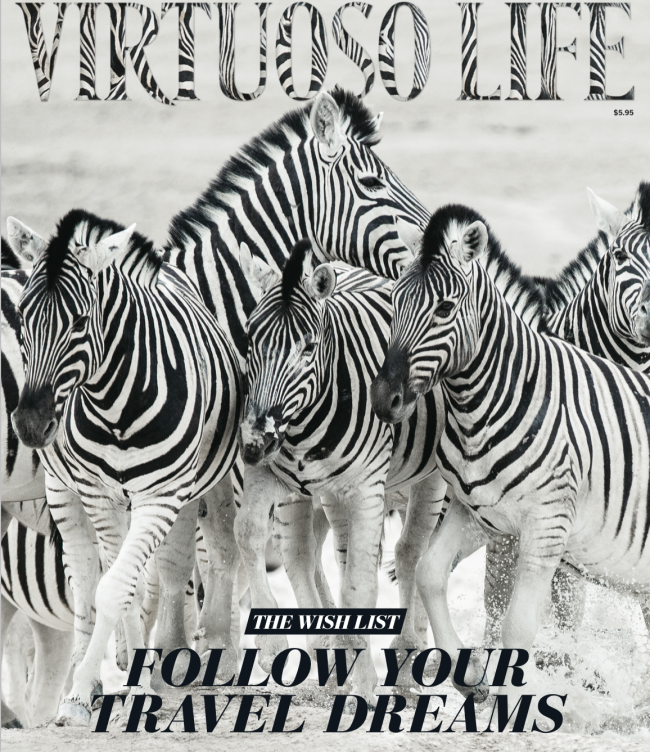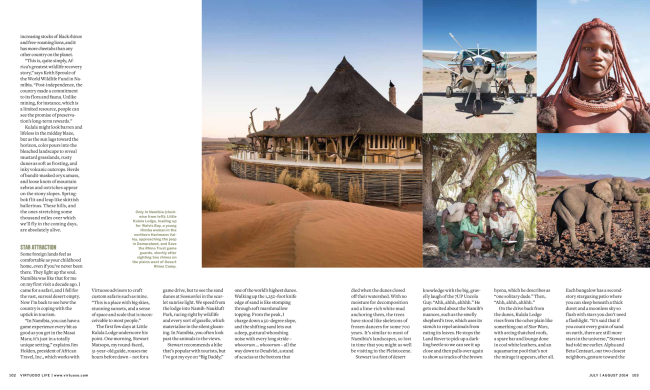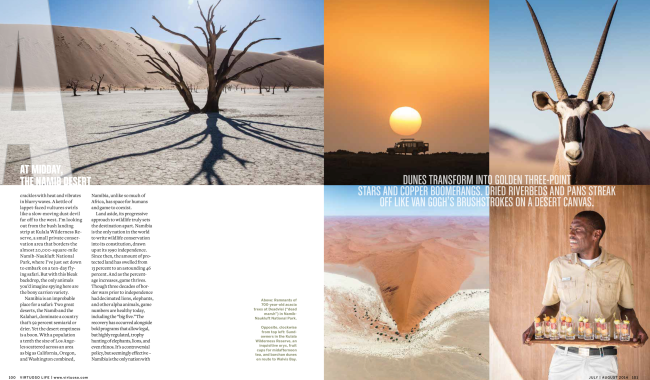Virtuoso Life
Art Director: Melanie Prasetyo Fowler
Photo Researcher: Mary Risher
Photographer: Jen Judge
Heidi: How often do you and your husband get hired as a team, are you promoting yourselves that way?
Jen: It’s something of a work in progress. Aaron and I have been working together on and off for about ten years. In the beginning, we found that most editors wanted the freedom and flexibility to hire writers and photographers independently. But as we’ve built relationships with editors over the years, they’ve learned that we produce really good work together (and we’re not just trying to score freebie trips). So we’ve been working together more and more, probably about 30% of the time. With the changing media world, we’re also taking steps to begin formally promoting ourselves as a team.
How did this assignment come about?
This is a story that Aaron has been wanting to write since our first trip to Namibia in 2005, and the country’s investment and dedication to wildlife conservation in the last few years had him looking for timely opportunities. Sometimes it’s just a matter of patience and persistence to get a story placed. So when the Adventure Travel Trade Association (ATTA) announced its annual conference in Namibia, we took it as the perfect opportunity, and he pitched the story to Virtuoso Life, a publication we regularly work for as a team and they loved the idea.
What was the biggest obstacle you faced with this project?
This was my first “re-assignment.” I had some anxiety about this trip for a number of reasons.
In 2005, Aaron was working as an editor and staffer at Outside magazine and had a story in Namibia for their travel title, Outside Traveler. At the time, I had a full time job in marketing in Santa Fe but was trying to return to my work in photography. So we convinced Outside to let me go with him and photograph the story. The only caveat, since I was a complete unknown, they wouldn’t assign it but would buy stock if they liked what I shot. Upon my return, they liked the images, but my employer didn’t like the time I’d taken off and fired me. Outside hired me for a Las Vegas feature a few months later, other publications saw my work, and the the rest was history. The idea of going back to a place that was the pivotal moment of my photography career was scary and exciting at the same time. I was curious to see how my vision had changed, but I was also nervous about trying to shoot the same thing over again. The fact that Aaron and I both independently won national magazine awards for this feature means a lot.
Travel assignments are the crown jewel for most photographers, what’s your best advice for someone wanting to break into this market?
Travel. You can’t get travel assignments if your work only show cases “local” travel work. Editors need to know you can handle yourself in foreign countries. Language barriers and local customs can be tough to deal with and can often make or break getting a great shot. Being able to adapt to your surroundings and set locals at ease is key.
How many days were you there traveling? and did you have a guide /driver?
Twelve days including travel to and from Namibia via South Africa. We were nine days on the ground. There was no driver, but a pilot flew us about the country.
How difficult was the edit and how many images do you typically turn in?
Edits are always hard. I love making photographs but I get a little stir crazy sitting in front of my computer for hours. I wouldn’t say this edit was any harder than others. The story and the length of time on the ground usually dictates how many images I shoot for a given story. This story was longer than most, so I shot more, about 5,000 images in total. I only like to turn in images I’m really excited about, so I typically submit about 200 and specifically call out about 50 of my favorites.
Does the job usually cover any type of shots, visas, immunizations?
It depends on the destination. As American citizens, we have a lot of flexibility and relatively easy access to other countries, which helps tremendously. For example, in Namibia visa’s were obtained on arrival and no immunizations were required. By contrast, Senegal required a long list of vaccines, and I’ve actually had to turn down two assignments to Brazil because I couldn’t get a visa in time. So every story and country is different.
With so much beauty and intrigue in front of you, is it hard to put down your camera? You must be constantly shooting since everything appears to be beautiful. How do you decide what to photograph (aside from the magazine’s shot list, if there is one)?
Since I was traveling with my husband (and writer), I didn’t get any shot list. We were creating the shot list as we went. In some ways, it’s harder to shoot in tandem with a writer. It means I have to cover everything we do because it’s all a work in progress and you don’t yet know what will or won’t be in the story. In those cases, I am always on.
Over the years, though, I’ve really had to learn to make myself step back. If I shoot constantly, I get overstimulated and don’t produce my best imagery. So I really work hard to conceptualize a few great shots a day and then go out and get them. It’s my way of being proactive and creating what I want versus running around and making mediocre pictures of a lot of things. Ultimately, I aim for variety and continue to check my image library each night to make sure I’m hitting all the bases. Great landscapes, people, architecture, lifestyle and culture, food, flora and fauna—and all at a variety of focal lengths.
Best local food and drink you enjoyed?
Any wild game is amazing, but in particular I love oryx. It’s the most tender, deep red, lean, and flavorful meat I’ve ever had, and I could eat it daily, washed down with a local brew of Windhoek beer, of course.





1 Comment
There’s only one word that comes to my mind when I see the first image: contrast. I love it!
Comments are closed for this article!